Eco-Efficiency Evaluation of Agricultural Production in the EU-28
Abstract
:1. Introduction
2. Materials and Methods
- The life cycle inventory (LCI) of agriculture for each of the member states of the European Union that involves the collection and calculation of relevant environmental inputs and outputs (indicators of natural resource consumption and environmental pressure indicators).
- The life cycle impact assessment (LCIA) of agriculture for every member state of the European Union in order to translate the results of the LCI drawn in the first step into their contributions to relevant impact categories.
- The eco-efficiency evaluation of agriculture for each member state of the European Union with the application of the DEA model, using a set of impact categories derived from the LCIA phase as input values and economic indicators as output values. This stage includes the process of environmental benchmarking.
2.1. Life Cycle Assessment (LCA)
2.1.1. Life Cycle Inventory (LCI)
- Consumption of energy [in thousands Mg of oil equivalent],
- Consumption of water [in million m3].
- Use of fertilizers (including nitrogen and phosphorus) [in thousands Mg],
- Use of pesticides (including fungicides and bactericides, herbicides, insecticides and acaricides, and molluscicides) and plant growth regulators [in Mg],
- Emissions to air (including ammonia, carbon dioxide, carbon monoxide, methane, nitrogen oxides, non-methane volatile organic compounds (NMVOC), sulphur oxides, and particulates <2.5 µm) [in thousands Mg],
- Production of waste (including chemical waste, recyclable waste (metal, glass, paper and cardboard, and plastic), wood waste, compost, sludge, mineral waste, and remaining waste) [in thousands Mg].
2.1.2. Life Cycle Impact Assessment (LCIA)
2.2. Data Envelopment Analysis (DEA)
3. Results
3.1. Inventory Analysis
3.2. Impact Assessment
3.3. DEA Performance
- Decision variablesθo, λo1, λo2, …… λo28
- Objective functionθo → min
- Problem Constraints1393λo1 + 2159λo2 + 370λo3 + …… +1779λo27 + 911λo28 ≥ 10920.21λo1 + 0.57λ o2 + 0.036λo3 + …… + 0.169λo27 + 0.180λo28 ≤ 0.251θo1.799λo1 + 3.56λo2 + 0.215λo3 + …… +1.364λo27 + 1.088λo28 ≤ 3.264θo0.641λo1 + 0.412λo2 + 0.709λo3 + …… + 0.544λo27 + 0.645λo28 ≤ 1.01θo0.58λo1 + 1.27λo2 + 0.523λo3 + …… + 0.643λo27 + 0.584λo28 ≤ 1.221θo0.238λo1 + 0.749λo2 + 0.073λo3 + …… + 0.377λo27 + 0.231λo28 ≤ 0.432θo0.687λo1 + 1.331λo2 + 0.087λo3 + …… + 0.539λo27 + 0.376λo28 ≤ 1.145θoλo1 + λo2 + λo3 + …… + λo27 + λo28 = 1θo ≤ 1
- Non-Negativity Constraintsθo, λo1, λo2, ……, λo28 ≥ 0.
- Eco-efficiency leaders, having eco-efficiency scores of 1 (i.e., agriculture in Belgium, Bulgaria, Estonia, Finland, Greece, Malta, the Netherlands, Romania, Sweden, and Italy);
- Eco-efficiency followers, having relatively high eco-efficiency scores, in the range of 0.99–0.80, (i.e., agriculture in Latvia (0.97), Lithuania (0.85), Luxembourg (0.87), Portugal (0.84), Slovakia (0.97), and the United Kingdom (0.82));
- Eco-efficiency moderates, having eco-efficiency scores in the range of 0.79–0.60 (i.e., agriculture in Austria (0.79), Croatia (0.64), Cyprus (0.76), the Czech Republic (0.65), Denmark (0.65), France (0.62), Hungary (0.72), and Spain (0.65)); and
- Eco-efficiency laggards, having eco-efficiency scores below 0.6 (i.e., Germany (0.48), Ireland (0.50), Poland (0.46) and Slovenia (0.50)).
4. Discussion
5. Conclusions
Author Contributions
Funding
Acknowledgments
Conflicts of Interest
Appendix A
| Country | Indicators of Natural Resources Consumption | Environmental Pressure Indicators | ||||||||||||||||||||||
|---|---|---|---|---|---|---|---|---|---|---|---|---|---|---|---|---|---|---|---|---|---|---|---|---|
| Fertilizers | Pesticides | Air Pollutants | Waste | |||||||||||||||||||||
| Consumption of Energy [in thousand Mg of oil equivalent] | Consumption of Water [in million m3] | Nitrogen Fertilizers | Phosphorus Fertilizers | Fungicides and Bactericides | Herbicides | Insecticides and Acaricides | Molluscicides | Plant Growth Regulators | Ammonia | Carbon Dioxide | Carbon Monoxide | Methane | Nitrogen Oxide | NMVOC | Sulphur Oxide | Particulates <2.5 µm | Chemical Waste * | Recyclable Waste * | Wood Waste * | Animal and Vegetable Waste * | Sludge * | Mineral Waste * | Waste, Remaining * | |
| [in thousand Mg] | [in Mg] | [in thousand Mg] | [in thousand Mg] | |||||||||||||||||||||
| Austria | 516 | M | 125 | 13 | 2128 | 1317 | 196 | 21 | 116 | 63 | 1527 | 26 | 183 | 21 | 11 | 0.1 | 2.4 | 10.5 | 14.7 | 22.2 | 61.0 | 0.1 | 0.3 | 19.4 |
| Belgium | 722 | 37 | 144 | 3 | 2586 | 2373 | 576 | 27 | 852 | 60 | 2126 | 8 | 239 | 19 | 32 | 0.8 | 2 | 64.3 | 9.5 | 1.6 | 122.0 | 1.5 | 5.7 | 60.2 |
| Bulgaria | 186 | 359 | 342 | 28 | 619 | 636 | 286 | 0.3 | 0.3 | 12 | 1083 | 3 | 32 | 8 | 12 | 0.3 | 0.3 | 0.4 | 1.4 | 1.3 | 773.0 | 0.4 | 21.8 | 37.3 |
| Croatia | 203 | 30 | 87 | 13 | 1315 | 821 | 139 | 6 | 30 | 24 | 785 | 2 | 55 | 6 | 8 | 0.2 | 0.5 | 0.5 | 1.6 | 0.0 | 258 | 0 | 0.1 | 74.5 |
| Cyprus | 41 | 56 | 8 | 0.8 | 698* | 153* | 180* | 1* | 1.2* | 4 | 84 | 0.3 | 15 | 0.8 | 0.8 | 0.0 | 0.1 | 0.8 | 0.7 | 1.4 | 10 | 0 | 0.07 | 54.5 |
| Czech Republic | 607 | 62 | 397 | 21 | 2119 | 2889 | 327 | 21 | 955 | 60 | 1600 | 23 | 141 | 33 | 3.5 | 0.6 | 3 | 2.7 | 6.5 | 1.0 | 26 | 5.4 | 18.7 | 74.5 |
| Denmark | 633 | 243 | 204 | 14 | 511 | 1903 | 55 | 11 | 126 | 69 | 2157 | 19 | 222 | 34 | 41 | 0.9 | 2 | 1.3 | 15.0 | 3.4 | 43 | 4.5 | 7.5 | 54.9 |
| Estonia | 132 | 5 | 36 | 4 | 109 | 472 | 28 | M | M | 10 | 85 | 1 | 25 | 3 | 5 | 0.0 | 0.3 | 6.4 | 2.6 | 5.7 | 89 | 0.002 | 11.6 | 5.8 |
| Finland | 695 | M | 143 | 11 | 225 | 1368 | 19 | M | 2519 | 29 | 1727 | 23 | 104 | 8 | 4 | 0.7 | 1 | 0.0 | 48.0 | 0.0 | 4 | 0.06 | 0.02 | 0 |
| France | 4192 | 2788* | 2208 | 187 | 27352 | 30575 | 2466 | 802 | 5683 | 664 | 14863 | 154 | 1638 | 173 | 310 | 1.8 | 20 | 43.0 | 132.0 | 7.0 | 742 | 0.02 | 0.6 | 348 |
| Germany | 715 | 288* | 1822 | 131 | 12602 | 16806 | 954 | 265 | 17966 | 724 | 14214 | 64 | 1299 | 174 | 218 | 2.0 | 14 | 0.8 | 18.1 | 7.7 | 285 | 3 | 52.4 | 71.9 |
| Greece | 258 | 7221 | 164 | 22 | 1927 | 1315 | 694 | 1 | 242 | 63 | 553 | 44 | 199 | 7 | 1.7 | 0.2 | 3 | 0.0 | 5.5 | 0 | 5 | 0 | 0 | 0 |
| Hungary | 577 | 323* | 358 | 36 | 3868 | 4270 | 827 | M | 519 | 69 | 2206 | 5 | 109 | 27 | 2.3 | 0.1 | 1.4 | 70.4 | 2.7 | 0.8 | 411 | 0.3 | 23.5 | 12.2 |
| Ireland | 221 | M | 331 | 37 | 688 | 2098 | 60 | 10 | 267 | 107 | 1088 | 1.4 | 489 | 6 | 43 | 0.1 | 2 | 23.7 | 48.5 | 0 | 12 | 0 | 0 | 11.8 |
| Italy | 2664 | M | 518 | 75 | 38861 | 7951 | 2429 | 90 | 13688 | 378 | 8170 | 115 | 742 | 82 | 15 | 0.1 | 11 | 65.5 | 38.8 | 18.7 | 70 | 99 | 2.4 | 38.5 |
| Latvia | 154 | 39 | 76 | 11 | 270 | 861 | 17 | 0.6 | 362 | 16 | 480 | 7 | 38 | 9 | 8 | 0.2 | 1 | 0.8 | 3.9 | 0.4 | 2 | 0 | 0.02 | 29.3 |
| Lithuania | 98 | 61 | 167 | 20 | 633 | 1289 | 28 | 0 | 303 | 25 | 444 | 1.4 | 76 | 13 | 10 | 0.5 | 0.7 | 2.2 | 9.8 | 14 | 348 | 0.005 | 25.7 | 21.6 |
| Luxembourg | 24 | 0.7 | 13 | 0.5 | M | 83 | M | 1 | 16 | 6 | 54 | 0.1 | 20 | 1 | 1.7 | 0.0 | 0.05 | 0.1 | 0.1 | 0.1 | 1 | 0.4 | 1 | 0.2 |
| Malta | 5 | 29 | 0.6 | 0.03 | 119 | 5 | 3 | 0.7 | 45 | 1 | 12 | 0.0 | 1 | 0.1 | 0.0 | 0.0 | 0.02 | 0.0 | 0.1 | 0.1 | 2 | 0 | 0.0 | 0.3 |
| Netherlands | 3583 | 125* | 245 | 4 | 4379 | 2881 | 292 | 34 | 2412 | 111 | 10045 | 10 | 556 | 58 | 3 | 0.5 | 3.5 | 2.7 | 22.7 | 3.8 | 4399 | 4.8 | 152 | 184 |
| Poland | 3366 | 990 | 1004 | 132 | 7738 | 12190 | 1539 | M | 2529 | 259 | 14222 | 229 | 580 | 163 | 22 | 41.6 | 23.5 | 1.3 | 6.82 | 2.3 | 386 | 0.5 | 55.3 | 40.1 |
| Portugal | 345 | M | 121 | 19 | 5193 | 2122 | 561 | 30 | 2095 | 46 | 1991 | 32 | 193 | 32 | 5 | 0.4 | 2 | 0.7 | 11.1 | 2.7 | 21 | 0.2 | 8.1 | 5.9 |
| Romania | 458 | 2 | 357 | 58 | 4142 | 6353 | 676 | 2 | 310 | 138 | 1358 | 18 | 512 | 12 | 73 | 0.05 | 4 | 7.5 | 3.9 | 0 | 541 | 0 | 0 | 6.8 |
| Slovakia | 150 | 30 | M | M | 639 | 1218 | 100 | M | 285 | 29 | 839 | 6 | 41 | 8 | 10 | 0.1 | 0.4 | 6.6 | 0.8 | 4.9 | 553 | 2.5 | 4.4 | 2.6 |
| Slovenia | 74 | 6.7 | 28 | 4 | 759 | 224 | 38 | M | 22 | 17 | 238 | 4 | 47 | 4 | 7 | 0.0 | 0.3 | 0.0 | 0.2 | 27.0 | 75 | 0.003 | 0.4 | 0.3 |
| Spain | 2262 | 21963 | 1068 | 180 | 36423 | 15586 | 6691 | 67 | 18449 | 459 | 12261 | 512 | 948 | 220 | 111 | 3.7 | 42.5 | 36.7 | 61.0 | 19.6 | 5358 | 6.7 | 15.2 | 320 |
| Sweden | 350 | M | 190 | 12 | 398 | 1829 | 30 | M | 50 | 52 | 2251 | 39 | 132 | 23 | 37 | 0.3 | 2 | 5.0 | 23.7 | 0 | 595 | 2.7 | 0 | 28 |
| United Kingdom | 863 | 1072 | 1049 | 86 | 6032 | 11464 | 658 | M | 3171 | 253 | 6375 | 53 | 1106 | 28 | 180 | 0.4 | 7.5 | 203 | 170 | 2.2 | 166 | 0.7 | 32.2 | 84 |
| Impact Category | Climate Change | Terrestrial Acidification | Freshwater Eutrophication | Marine Eutrophication | Photochemical Oxidant Formation | Particulate Matter Formation | Terrestrial Ecotoxicity | Freshwater Ecotoxicity | Marine Ecotoxicity | Human Toxicity | Ionising Radiation | Ozone Depletion | Agricultural Land Occupation | Urban land Occupation | Natural Land Transformation | Metal Depletion | Fossil Depletion | |
|---|---|---|---|---|---|---|---|---|---|---|---|---|---|---|---|---|---|---|
| Impact Category | NO. | 1 | 2 | 3 | 4 | 5 | 6 | 7 | 8 | 9 | 10 | 11 | 12 | 13 | 14 | 15 | 16 | 17 |
| Climate change | 1 | 1.00 | 0.62 | −0.26 | 0.79 | 0.78 | 0.71 | 0.95 | 0.94 | 0.94 | 0.95 | 0.95 | 0.95 | 0.95 | 0.95 | 0.95 | 0.95 | 0.95 |
| Terrestrial acidification | 2 | 0.62 | 1.00 | −0.26 | 0.85 | 0.42 | 0.99 | 0.54 | 0.61 | 0.61 | 0.56 | 0.54 | 0.54 | 0.56 | 0.54 | 0.54 | 0.56 | 0.54 |
| Freshwater eutrophication | 3 | −0.2 | −0.2 | 1.00 | −0.1 | −0.1 | −0.2 | −0.3 | −0.30 | −0.3 | −0.3 | −0.3 | −0.3 | −2.3 | −2.2 | −2.3 | −2.3 | −2.28 |
| Marine eutrophication | 4 | 0.79 | 0.85 | −0.16 | 1.00 | 0.69 | 0.89 | 0.68 | 0.71 | 0.72 | 0.69 | 0.68 | 0.68 | 0.69 | 0.68 | 0.68 | 0.69 | 0.68 |
| Photochemical oxidant formation | 5 | 0.78 | 0.42 | −0.11 | 0.69 | 1.00 | 0.51 | 0.63 | 0.61 | 0.61 | 0.63 | 0.63 | 0.64 | 0.63 | 0.63 | 0.64 | 0.63 | 0.64 |
| Particulate matter formation | 6 | 0.71 | 0.99 | −0.25 | 0.89 | 0.51 | 1.00 | 0.63 | 0.69 | 0.69 | 0.65 | 0.63 | 0.63 | 0.65 | 0.63 | 0.63 | 0.65 | 0.63 |
| Terrestrial ecotoxicity | 7 | 0.95 | 0.54 | −0.29 | 0.68 | 0.63 | 0.63 | 1.00 | 0.99 | 0.99 | 0.99 | 0.99 | 0.99 | 0.99 | 0.99 | 0.99 | 0.99 | 0.99 |
| Freshwater ecotoxicity | 8 | 0.94 | 0.61 | −0.30 | 0.71 | 0.61 | 0.69 | 0.99 | 1.00 | 0.99 | 0.99 | 0.99 | 0.99 | 0.99 | 0.99 | 0.99 | 0.99 | 0.99 |
| Marine ecotoxicity | 9 | 0.94 | 0.61 | −0.31 | 0.72 | 0.61 | 0.69 | 0.99 | 0.99 | 1.00 | 0.99 | 0.99 | 0.99 | 0.99 | 0.99 | 0.99 | 0.99 | 0.99 |
| Human toxicity | 10 | 0.95 | 0.56 | −0.29 | 0.69 | 0.63 | 0.65 | 0.99 | 0.99 | 0.99 | 1.00 | 0.99 | 0.99 | 0.99 | 0.99 | 0.99 | 0.99 | 0.99 |
| Ionising radiation | 11 | 0.95 | 0.54 | −2.29 | 0.68 | 0.63 | 0.63 | 0.99 | 0.99 | 0.99 | 0.99 | 1.00 | 0.99 | 0.99 | 0.99 | 0.99 | 0.99 | 0.99 |
| Ozone depletion | 12 | 0.95 | 0.54 | −0.28 | 0.68 | 0.64 | 0.63 | 0.99 | 0.99 | 0.99 | 0.99 | 0.99 | 1.00 | 0.99 | 0.99 | 0.99 | 0.99 | 0.99 |
| Agricultural land occupation | 13 | 0.95 | 0.56 | −0.29 | 0.69 | 0.63 | 0.65 | 0.99 | 0.99 | 0.99 | 0.99 | 0.99 | 0.99 | 1.00 | 0.99 | 0.99 | 0.99 | 0.99 |
| Urban land occupation | 14 | 0.95 | 0.54 | −2.29 | 0.68 | 0.63 | 0.63 | 0.99 | 0.99 | 0.99 | 0.99 | 0.99 | 0.99 | 0.99 | 1.00 | 0.99 | 0.99 | 0.99 |
| Natural Land Transformation | 15 | 0.95 | 0.54 | −2.28 | 0.68 | 0.64 | 0.63 | 0.99 | 0.99 | 0.99 | 0.99 | 0.99 | 0.99 | 0.99 | 0.99 | 1.00 | 0.99 | 0.99 |
| Metal depletion | 16 | 0.95 | 0.56 | −2.29 | 0.69 | 0.63 | 0.65 | 0.99 | 0.99 | 0.99 | 0.99 | 0.99 | 0.99 | 0.99 | 0.99 | 0.99 | 1.00 | 0.99 |
| Fossil depletion | 17 | 0.95 | 0.54 | −2.28 | 0.68 | 0.64 | 0.63 | 0.99 | 0.99 | 0.99 | 0.99 | 0.99 | 0.99 | 0.99 | 0.99 | 0.99 | 0.99 | 1.00 |
| Country | GDP | ||
|---|---|---|---|
| [in million Euro] | [in percent of the country total] | [in percent of the EU agriculture total] | |
| Austria | 3789 | 1.1 | 1.9 |
| Belgium | 2873 | 0.7 | 1.4 |
| Bulgaria | 1857 | 4.1 | 0.9 |
| Croatia | 1558 | 3.5 | 0.8 |
| Cyprus | 319 | 1.8 | 0.2 |
| Czech Republic | 3706 | 2.2 | 1.7 |
| Denmark | 2174 | 0.8 | 1.1 |
| Estonia | 549 | 2.7 | 0.3 |
| Finland | 4611 | 2.2 | 2.3 |
| France | 35108 | 1.6 | 17.4 |
| Germany | 18262 | 0.6 | 8.9 |
| Greece | 6524 | 3.7 | 3.3 |
| Hungary | 4097 | 3.7 | 2.0 |
| Ireland | 2358 | 0.9 | 0.9 |
| Italy | 33052 | 2.0 | 16.4 |
| Latvia | 876 | 3.6 | 0.4 |
| Lithuania | 1273 | 3.4 | 0.6 |
| Luxembourg | 104 | 0.2 | 0.1 |
| Malta | 105 | 1.1 | 0.1 |
| Netherlands | 10935 | 1.6 | 5.4 |
| Poland | 9461 | 2.2 | 4.6 |
| Portugal | 3776 | 2.1 | 1.8 |
| Romania | 6733 | 4.2 | 3.2 |
| Slovakia | 2683 | 3.4 | 1.3 |
| Slovenia | 777 | 2.0 | 0.4 |
| Spain | 27000 | 2.5 | 13.1 |
| Sweden | 5388 | 1.2 | 2.6 |
| United Kingdom | 15613 | 0.6 | 6.9 |
References
- EU (the European Parliament and the Council). Decision No 1386/2013/EU on a General Union Environment Action Programme to 2020 ‘Living Well, within the Limits of Our Planet’; EU: Brussels, Belgium. Available online: https://eur-lex.europa.eu/legal-content/EN/TXT/PDF/?uri=CELEX:32013D1386&from=EN (accessed on 20 March 2018).
- COM (Commission of the European Communities). Communication from the Commission to the Council and the European Parliament ‘Indicators for the Integration of Environmental Concerns into the Common Agricultural Policy’; COM: Brussels, Belgium, 2000. [Google Scholar]
- Godard, C.; Bamière, L.; Debove, E.; De Cara, S.; Jayet, P.A.; Niang, N.B. Interface between Agriculture and the Environment: Integrating Yield Response Functions in an Economic Model of EU Agriculture. Modelling Agricultural Policies: State of the Art and New Challenges; University of Parma: Parma, Italy, 2005; pp. 475–494. [Google Scholar]
- International Organization for Standardization. Environmental Management—Eco-Efficiency Assessment of Product Systems—Principles, Requirements and Guidelines; International Organization for Standardization: Geneva, Switzerland, 2012. [Google Scholar]
- Huppes, G.; Ishikawa, M. A framework for quantified eco-efficiency analysis. J. Ind. Ecol. 2005, 9, 25–41. [Google Scholar] [CrossRef]
- Huppes, G.; Ishikawa, M. A Quantified Eco-Efficiency an Introduction with Applications; Springer: Dordrecht, The Netherlands, 2007; ISBN 978-1-4020-5399-3. [Google Scholar]
- WBCSD (World Business Council for Sustainable Development). Eco-Efficiency Learning Module. 2005. Available online: http://www.wbcsd.org/pages/EDocument/EDocumentDetails.aspx?ID=13593 (accessed on 30 June 2018).
- Yu, Y.; Chen, D.; Zhu, B.; Hu, S. Eco-efficiency trends in China, 1978–2010: Decoupling environmental pressure from economic growth. Ecol. Indic. 2013, 24, 177–184. [Google Scholar] [CrossRef]
- Zhang, B.; Bi, J.; Fan, Z.; Yuan, Z.; Ge, J. Eco-efficiency analysis of industrial system in China: A data envelopment analysis approach. Ecol. Econ. 2008, 68, 306–316. [Google Scholar] [CrossRef]
- Dyckhoff, H.; Allen, K. Measuring ecological efficiency with data envelopment analysis. Eur. J. Oper. Res. 2001, 132, 312–325. [Google Scholar] [CrossRef]
- Kuosmanen, T.; Kortelainen, M. Measuring eco-efficiency of production with data envelopment analysis. J. Ind. Ecol. 2005, 9, 59–72. [Google Scholar] [CrossRef]
- Huang, J.; Yang, H.; Cheng, G.; Wang, S. A comprehensive eco-efficiency model and dynamics of regional eco-efficiency in China. J. Clean. Prod. 2014, 67, 228–238. [Google Scholar] [CrossRef]
- Rybaczewska-Błażejowska, M.; Masternak-Janus, A. Eco-efficiency assessment of Polish regions: Joint application of life cycle assessment and data envelopment analysis. J. Clean. Prod. 2018, 172, 1180–1192. [Google Scholar] [CrossRef]
- Lozano, S.; Iribarren, D.; Moreira, M.T.; Feijoo, G. The link between operational efficiency and environmental impacts: A joint application of life cycle assessment and data envelopment analysis. Sci. Total Environ. 2009, 407, 1744–1754. [Google Scholar] [CrossRef]
- Iribarren, D.; Vázquez-Rowe, I.; Moreira, M.T.; Feijoo, G. Further potentials in the joint implementation of life cycle assessment and data envelopment analysis. Sci. Total Environ. 2010, 408, 5265–5272. [Google Scholar] [CrossRef]
- Mouron, P.; Scholz, R.W.; Nemecek, T.; Weber, O. Life cycle management on Swiss fruit farms: Relating environmental and income indicators for apple-growing. Ecol. Econ. 2006, 58, 561–578. [Google Scholar] [CrossRef]
- Iribarren, D.; Hospido, A.; Moreira, M.T.; Feijoo, G. Benchmarking environmental and operational parameters through eco-efficiency criteria for dairy farms. Sci. Total Environ. 2011, 409, 1786–1798. [Google Scholar] [CrossRef] [PubMed]
- Basset-Mens, C.; Ledgard, S.; Boyes, M. Eco-efficiency of intensification scenarios for milk production in New Zealand. Ecol. Econ. 2009, 68, 1615–1625. [Google Scholar] [CrossRef]
- Picazo-Tadeo, A.J.; Gómez-Limón, J.A.; Reig-Martinez, E. Assessing farming eco-efficiency: A Data Envelopment Analysis approach. J. Environ. Manag. 2011, 92, 1154–1164. [Google Scholar] [CrossRef] [PubMed]
- Gómez-Limón, J.A.; Picazo-Tadeo, A.J.; Reig-Martinezb, E. Eco-efficiency assessment of olive farms in Andalusia. Land Use Policy 2012, 29, 395–406. [Google Scholar] [CrossRef]
- Vázquez-Rowe, I.; Villanueva-Rey, P.; Iribarren, D.; Teresa Moreira, M.; Feijoo, G. Joint life cycle assessment and data envelopment analysis of grape production for vinification in the Rias Baixasappellation (NW Spain). J. Clean. Prod. 2012, 27, 92–102. [Google Scholar] [CrossRef]
- Jan, P.; Dux, D.; Lips, M.; Alig, M.; Dumondel, M. On the link between economic and environmental performance of Swiss dairy farms of the alpine area. Int. J. Life Cycle Assess. 2012, 17, 706–719. [Google Scholar] [CrossRef]
- Mohammadi, A.; Rafiee, S.; Jafari, A.; Dalgaard, T.; Knudsen, M.T.; Keyhani, A.; Mousavi-Avval, S.; Hermansen, J. Potential greenhouse gas emission reductions in soybean farming: A combined use of life cycle assessment and data envelopment analysis. J. Clean. Prod. 2013, 54, 89–100. [Google Scholar] [CrossRef]
- Mohammadi, A.; Rafiee, S.; Jafari, A.; Keyhani, A.; Dalgaard, T.; Knudsen, M.T.; Nguyen, T.; Borek, R.; Hermansen, J. Joint Life Cycle Assessment and Data Envelopment Analysis for the benchmarking of environmental impacts in rice paddy production. J. Clean. Prod. 2015, 106, 521–532. [Google Scholar] [CrossRef]
- Masuda, K. Measuring eco-efficiency of wheat production in Japan: A combined application of life cycle assessment and data envelopment analysis. J. Clean. Prod. 2016, 126, 373–381. [Google Scholar] [CrossRef]
- Pang, J.; Chen, X.; Zhang, Z.; Li, H. Measuring eco-efficiency of agriculture in China. Sustainability 2016, 8, 398. [Google Scholar] [CrossRef]
- Ullah, A.; Perret, S.R.; Gheewala, S.H.; Soni, P. Eco-efficiency of cotton-cropping systems in Pakistan: An integrated approach of life cycle assessment and data envelopment analysis. J. Clean. Prod. 2016, 134, 623–632. [Google Scholar] [CrossRef]
- Forleo, B.; Palmieri, N.; Suardi, A.; Coaloa, D.; Pari, L. The eco-efficiency of rapeseed and sunflower cultivation in Italy. Joining environmental and economic assessment. J. Clean. Prod. 2018, 172, 3138–3153. [Google Scholar] [CrossRef]
- Mohseni, P.; Borghei, A.M.; Khanali, M. Coupled life cycle assessment and data envelopment analysis for mitigation of environmental impacts and enhancement of energy efficiency in grape production. J. Clean. Prod. 2018, 197, 937–947. [Google Scholar] [CrossRef]
- Gancone, A.; Pubule, J.; Rosa, M.; Blumberga, D. Evaluation of agriculture eco-efficiency in Latvia. Energy Procedia 2017, 128, 309–315. [Google Scholar] [CrossRef]
- Vlontzos, G.; Pardalos, M.P. Assess and prognosticate greenhouse gas emissions from agricultural production of EU countries, by implementing, DEA Window analysis and artificial neural networks. Renew. Sustain. Energy Rev. 2017, 76, 155–162. [Google Scholar] [CrossRef]
- Vlontzos, G.; Niavis, S.; Pardalos, M.P. Testing for Environmental Kuznets Curve in the EU Agricultural Sector through an Eco-(in)Efficiency Index. Energies 2017, 10, 1992. [Google Scholar] [CrossRef]
- International Organization for Standardization. Environmental Management—Life Cycle Assessment—Principles and Framework; International Organization for Standardization: Geneva, Switzerland, 2006. [Google Scholar]
- International Organization for Standardization. Environmental Management—Life Cycle Assessment—Requirements and Guidelines; International Organization for Standardization: Geneva, Switzerland, 2006. [Google Scholar]
- Cerutti, A.; Beccaro, G.; Bruun, S.; Bosco, S.; Donno, D.; Notarnicola, B.; Bounous, G. Life-cycle assessment application in the fruit sector: State of the art and recommendations for environmental declarations of fruit products. J. Clean. Prod. 2014, 73, 125–135. [Google Scholar] [CrossRef]
- Haas, G.; Wetterich, F.; Geier, U. Life Cycle Assessment Framework in Agriculture on the Farm Level. Int. J. Life Cycle Assess. 2000, 5, 345–348. [Google Scholar] [CrossRef]
- Eurostat (European Statistical Office). Land Use: Number of Farms and Areas of Different Crops by Type of Farming. 2017. Available online: http://appsso.eurostat.ec.europa.eu/nui/show.do?dataset=ef_oluft&lang=en (accessed on 6 March 2018).
- Guinee, J.B. Handbook on Life Cycle Assessment. Operational Guide to the ISO Standards; Kluwer Academic Publishers: Dordrecht, The Netherlands, 2004; ISBN 978-0-306-48055-3. [Google Scholar]
- Zarębska, J. SimaPro jako uniwersalny program do oceny cyklu życia (LCA). [SimaPro as an universal life cycle assessment (LCA) software]. Ekonomia i Organizacja Przedsiębiorstwa 2010, 4, 92. [Google Scholar]
- Goedkoop, M.; Heijungs, R.; Huijbregts, M.; De Schryver, A.; Struijs, J.; van Zelm, R. ReCiPe 2008 a Life Cycle Impact Assessment Method Which Comprises Harmonised Category Indicators at the Midpoint and the Endpoint Level; Ministry of Housing, Spatial Planning and Environment (VROM): Barendrecht, The Netherlands, 2013. [Google Scholar]
- Charnes, A.; Cooper, W.W.; Rhodes, E. Measuring the efficiency of decision making units. Eur. J. Oper. Res. 1978, 2, 429–444. [Google Scholar] [CrossRef]
- Eurostat (European Statistical Office). Agri-Environmental Indicator—Energy Use. 2018. Available online: http://ec.europa.eu/eurostat/en/web/products-datasets/-/NRG_100A (accessed on 6 February 2018).
- Eurostat (European Statistical Office). Water Use by Supply Category and Economical Sector. 2018. Available online: http://appsso.eurostat.ec.europa.eu/nui/show.do?dataset=env_wat_cat&lang=en (accessed on 6 February 2018).
- OECD (Organisation for Economic Co-operation and Development). Agri-Environmental Other Indicators—Agriculture Freshwater Abstraction. 2018. Available online: https://stats.oecd.org/viewhtml.aspx?datasetcode=AEI_OTHER&lang=en# (accessed on 6 March 2018).
- Eurostat (European Statistical Office). Agri-Environmental Indicator—Mineral Fertilizer Consumption. 2018. Available online: http://appsso.eurostat.ec.europa.eu/nui/show.do?dataset=aei_fm_usefert&lang=en (accessed on 6 February 2018).
- Eurostat (European Statistical Office). Agri-Environmental Indicator—Consumption of Pesticides. 2018. Available online: http://appsso.eurostat.ec.europa.eu/nui/show.do?dataset=aei_fm_salpest09&lang=en (accessed on 6 February 2018).
- Eurostat (European Statistical Office). Air Emissions Accounts by NACE. 2018. Available online: http://appsso.eurostat.ec.europa.eu/nui/show.do?dataset=env_ac_ainah_r2&lang=en (accessed on 6 February 2018).
- Eurostat (European Statistical Office). Generation of Waste by the Agriculture, Forestry and Fishing Sector, by Country, Year and Waste Category. 2018. Available online: http://appsso.eurostat.ec.europa.eu/nui/show.do?dataset=env_wasgen&lang=en (accessed on 6 February 2018).
- Lewin, A.Y.; Morey, R.C.; Cook, T.J. Evaluating the administrative efficiency of courts. Omega 1982, 10, 401–411. [Google Scholar] [CrossRef]
- Avkiran, N.K. Productivity Analysis in the Service Sector with Data Envelopment Analysis, 3rd ed.; The University of Queensland: Brisbane, Australia, 2006. [Google Scholar]
- Banker, R.D.; Charnes, A.; Cooper, W.W.; Swarts, J.; Thomas, D. An introduction to data envelopment analysis with some of its models and their uses. Res. Gov. Non-Profit Account. 1989, 5, 125–163. [Google Scholar]
- Eurostat (European Statistical Office). Gross Domestic Product and Main Components (Output, Expenditure and Income). 2018. Available online: http://appsso.eurostat.ec.europa.eu/nui/show.do?dataset=nama_10_gdp&lang=en (accessed on 19 February 2018).
- Eurostat (European Statistical Office). Gross Value Added and Income by A *10 Industry Breakdowns. Percentage of Gross Domestic Products (GDP). 2018. Available online: http://appsso.eurostat.ec.europa.eu/nui/show.do?dataset=nama_10_a10&lang=en (accessed on 19 February 2018).
- Masternak-Janus, A.; Rybaczewska-Błażejowska, M. Comprehensive regional eco-efficiency analysis based on date envelopment analysis: The case study of Polish regions. J. Ind. Ecol. 2017, 21, 180–190. [Google Scholar] [CrossRef]
- European Commission. Agriculture in the European Union and the Member States—Statistical Factsheets. 2017. Available online: https://ec.europa.eu/agriculture/statistics/factsheets_en (accessed on 27 April 2018).
- Brentrup, F.; Kusters, J.; Kuhlmann, H.; Lammel, J. Environmental impact assessment of agricultural production systems using the life cycle assessment methodology I. Theoretical concept of a LCA method tailored to crop production. Eur. J. Agron. 2004, 20, 247–264. [Google Scholar] [CrossRef]
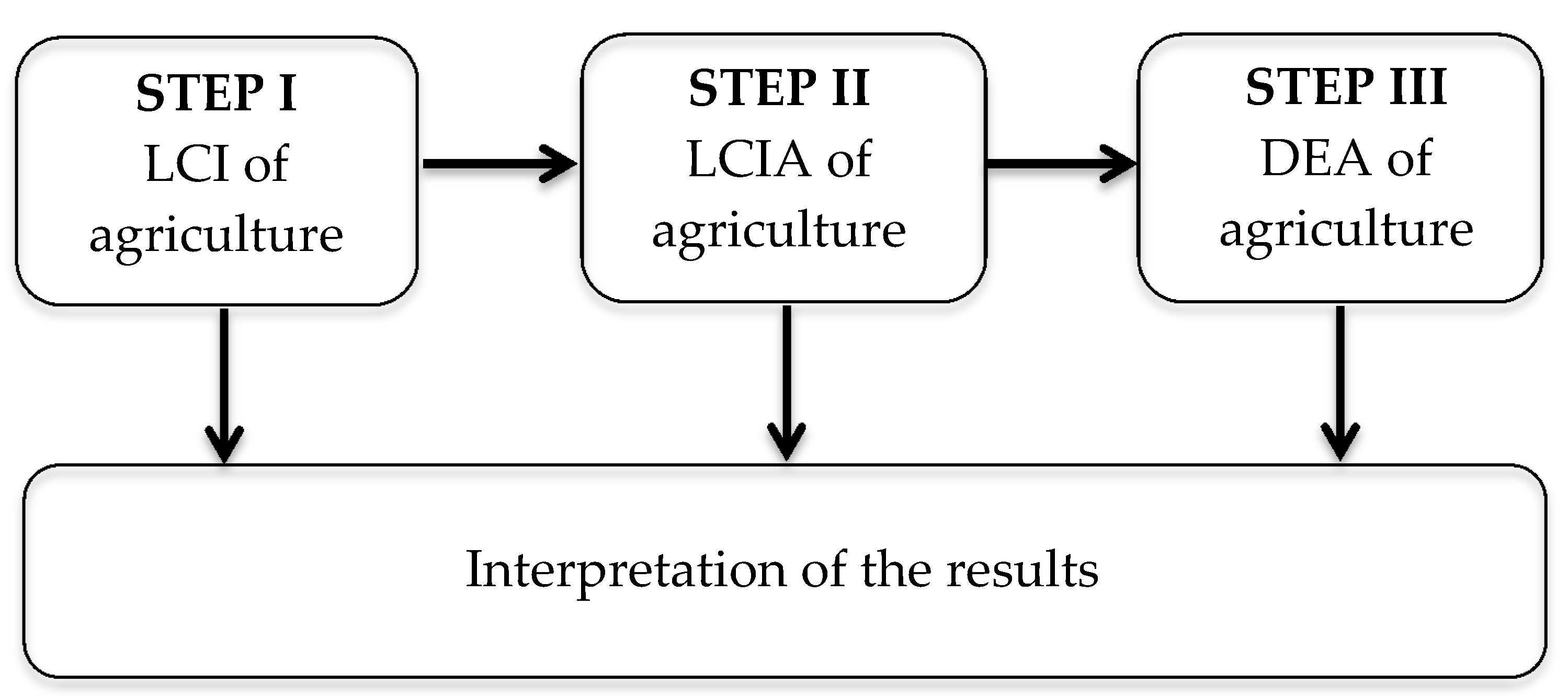
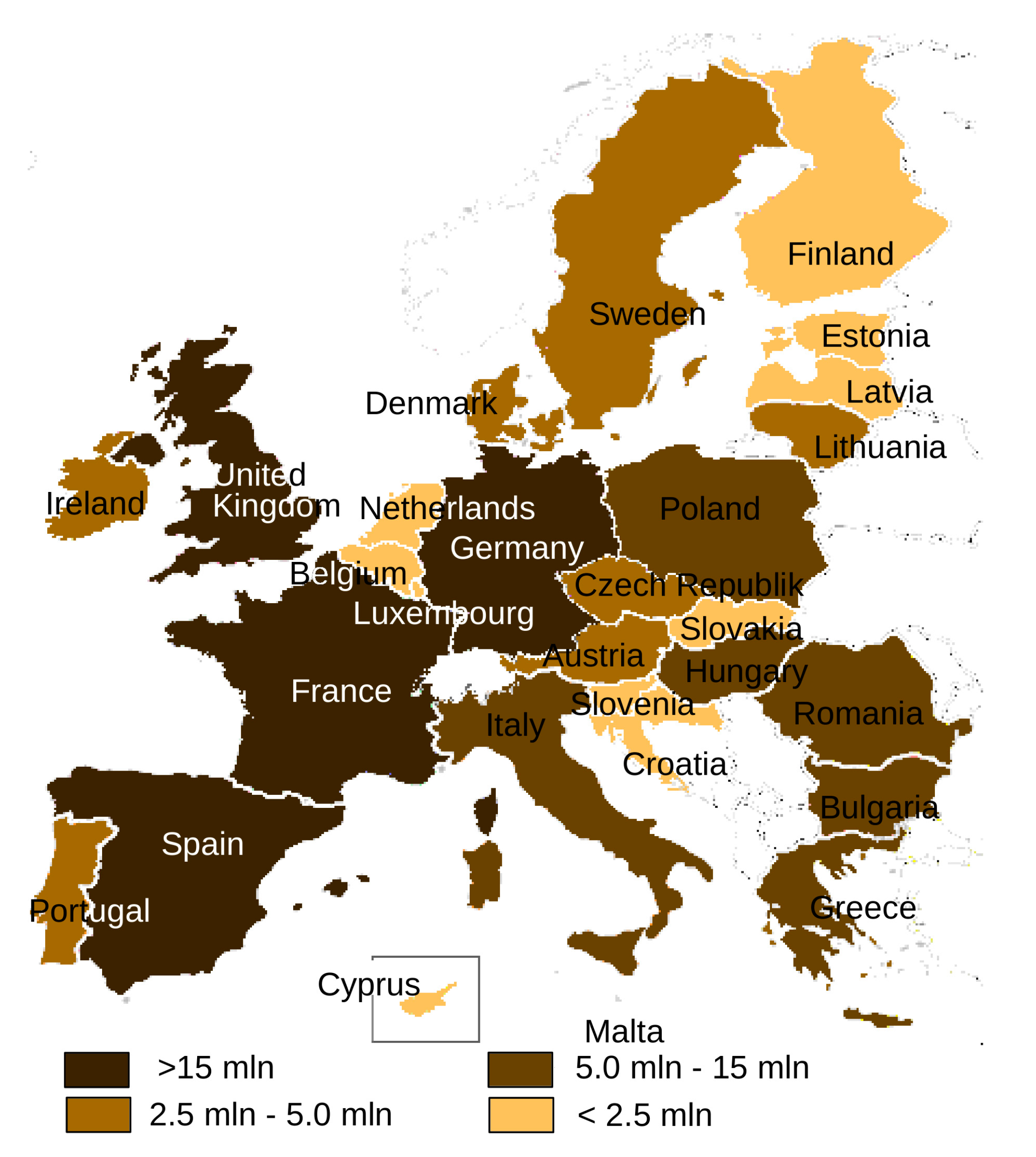
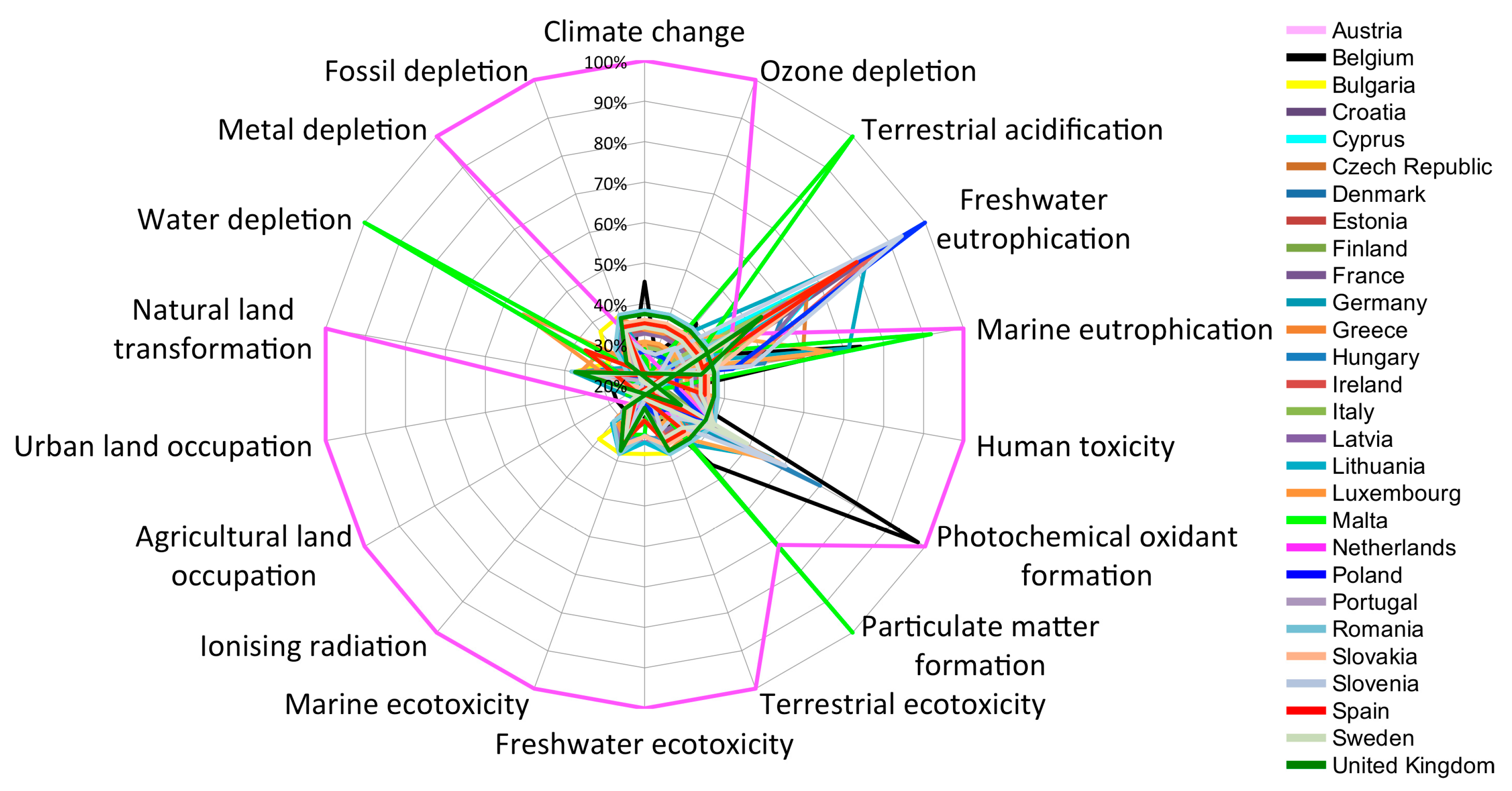
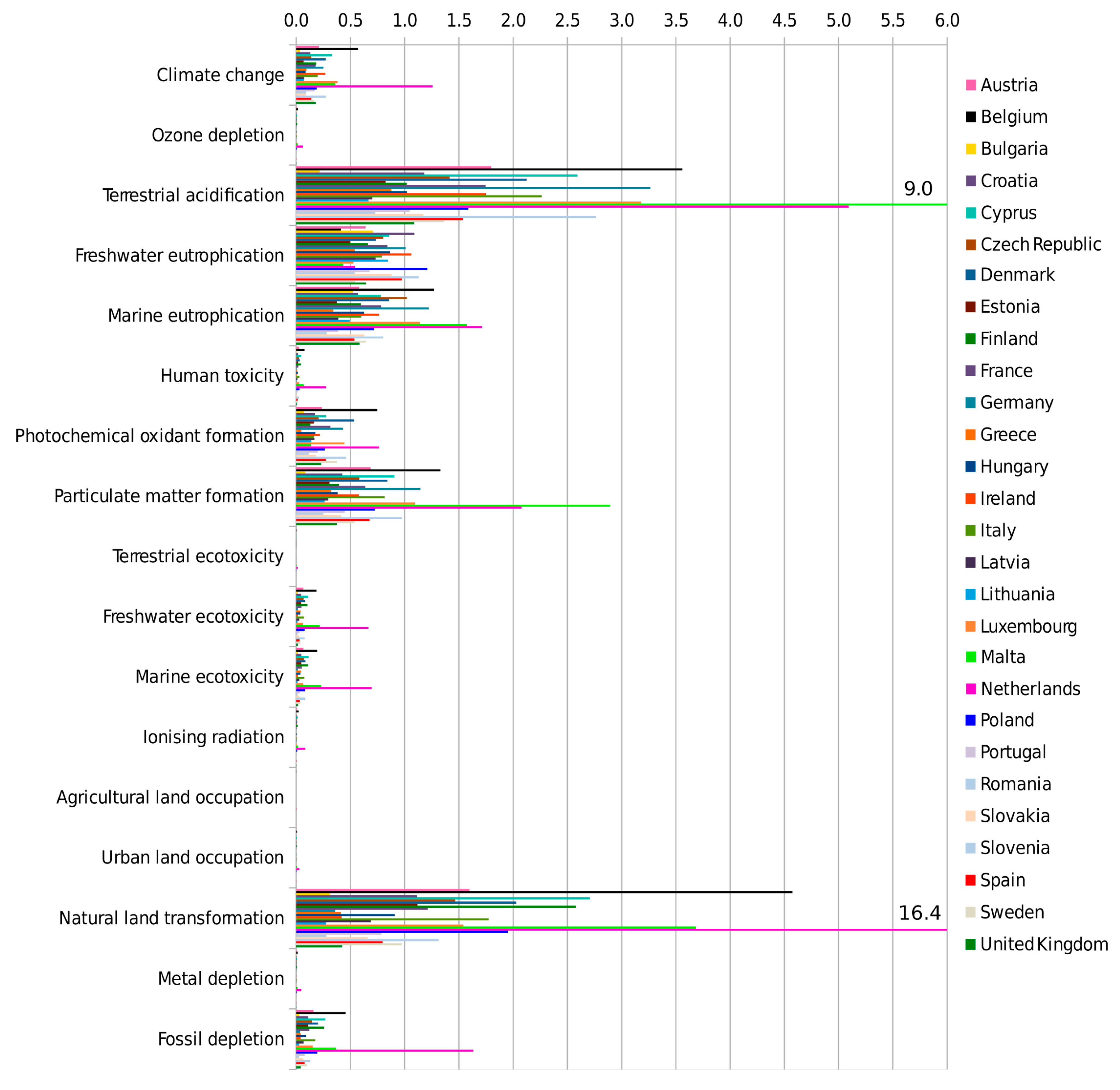
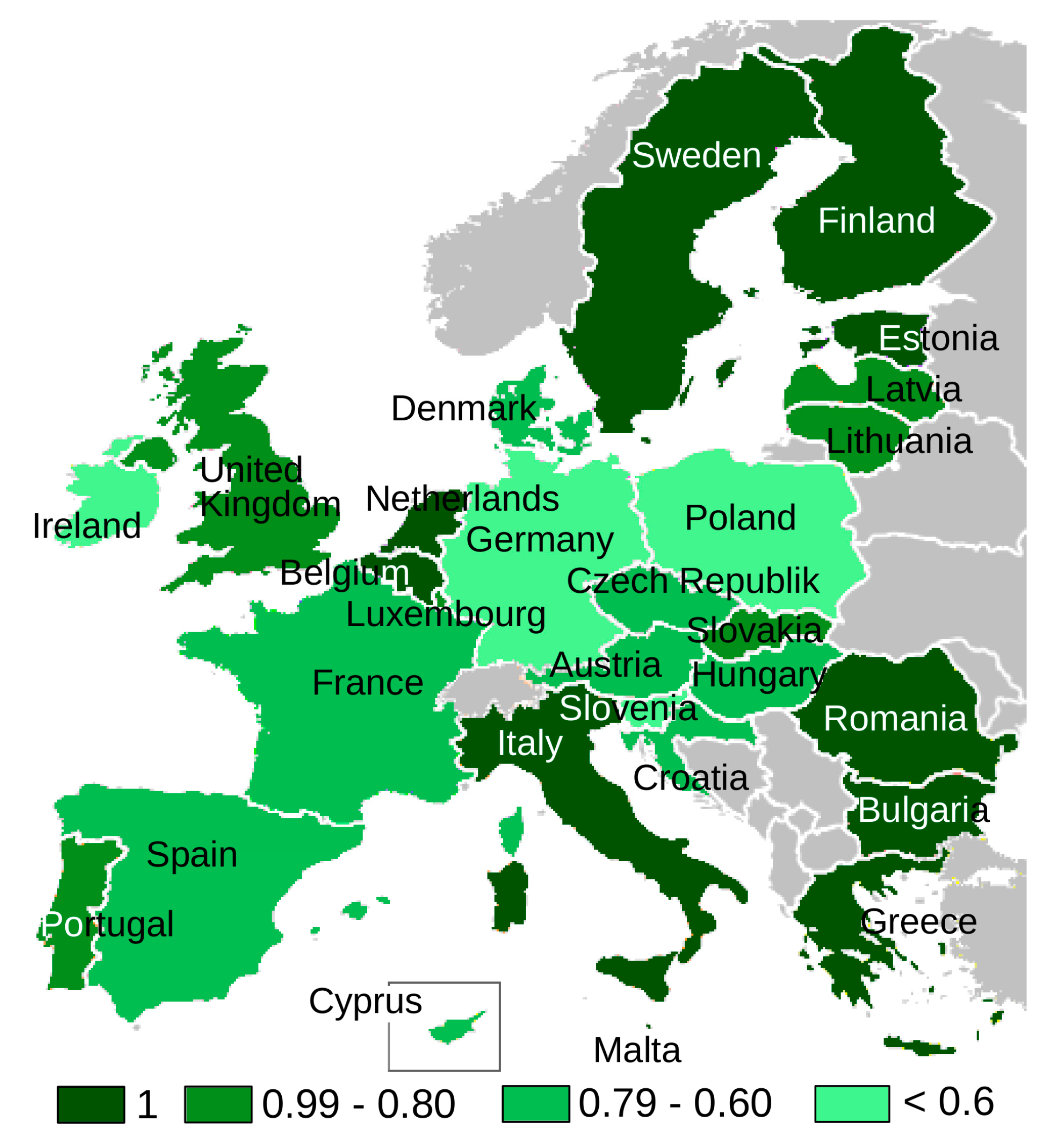
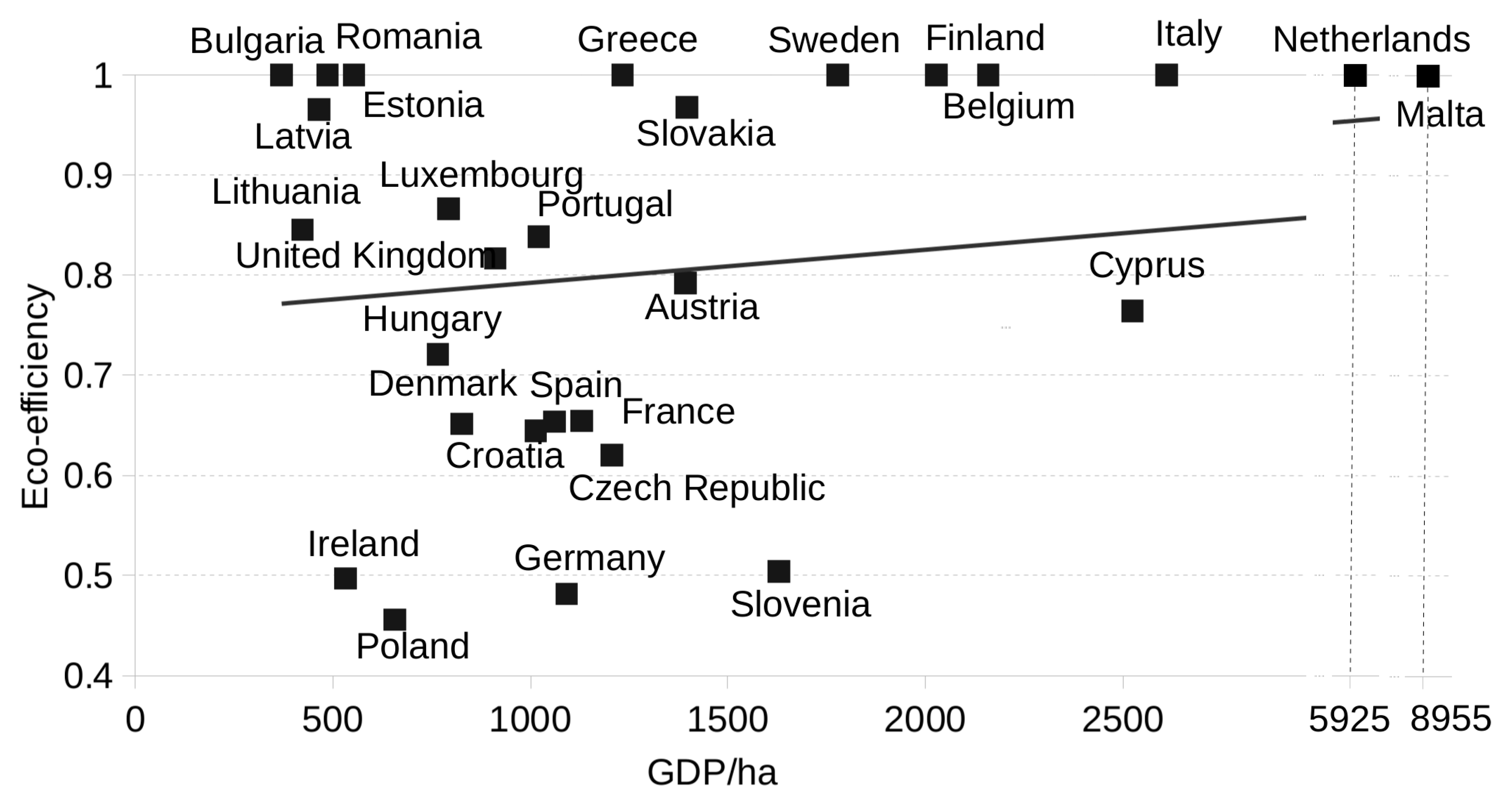

| Impact Category | Climate Change | Ozone Depletion | Terrestrial Acidification | Freshwater Eutrophication | Marine Eutrophication | Human Toxicity | Photochemical Oxidant Formation | Particulate Matter Formation | Ecotoxicity | Ionising Radiation | Land Occupation | Natural land Transformation | Water Depletion | Metal Depletion | Fossil Depletion | |
|---|---|---|---|---|---|---|---|---|---|---|---|---|---|---|---|---|
| Unit | kg CO2 eq | kg CFC-11 eq | kg SO2 eq | kg P eq | kg N eq | kg 1,4-DB eq | kg NMVOC | kg PM10 eq | kg 1,4-DB eq | kBq U235 eq | m2a | m2 | m3 | kg Fe eq | kg oil eq | |
| Country | ||||||||||||||||
| Austria | 2357 | 0.0001 | 61.81 | 0.26 | 5.87 | 17.02 | 13.54 | 10.2 | 1.32 | 51 | 2.70 | 0.26 | 0.05 | 3.35 | 248 | |
| Belgium | 6395 | 0.0004 | 122.35 | 0.17 | 12.85 | 48.71 | 42.54 | 19.8 | 3.78 | 146 | 7.73 | 0.74 | 28.13 | 9.58 | 710 | |
| Bulgaria | 399 | 0 | 7.39 | 0.29 | 5.29 | 3.54 | 4.17 | 1.29 | 0.31 | 10 | 0.55 | 0.05 | 71.73 | 0.70 | 49 | |
| Croatia | 1478 | 0 | 40.60 | 0.45 | 5.78 | 11.86 | 9.97 | 6.34 | 0.92 | 36 | 1.88 | 0.18 | 19.54 | 2.33 | 173 | |
| Cyprus | 3720 | 0.0002 | 89.07 | 0.36 | 7.88 | 28.83 | 15.82 | 13.48 | 2.24 | 86 | 4.58 | 0.44 | 442.16 | 5.67 | 420 | |
| Czech Republic | 1567 | 0 | 48.63 | 0.33 | 10.34 | 16.25 | 11.77 | 8.68 | 1.38 | 47 | 2.54 | 0.24 | 17.61 | 3.20 | 227 | |
| Denmark | 3070 | 0.0002 | 73.03 | 0.31 | 8.67 | 21.60 | 30.41 | 12.54 | 1.68 | 65 | 3.43 | 0.33 | 92.44 | 4.25 | 314 | |
| Estonia | 786 | 0 | 28.35 | 0.21 | 3.79 | 11.92 | 9.38 | 4.60 | 0.92 | 36 | 1.89 | 0.18 | 5.16 | 2.35 | 174 | |
| Finland | 2080 | 0.0002 | 34.96 | 0.27 | 6.06 | 27.47 | 7.48 | 5.90 | 2.13 | 82 | 4.36 | 0.42 | 0.08 | 5.41 | 400 | |
| France | 2001 | 0 | 60.01 | 0.35 | 7.93 | 12.93 | 17.95 | 9.52 | 1.00 | 38.74 | 2.05 | 0.20 | 95.79 | 2.54 | 188 | |
| Germany | 2816 | 0 | 112.18 | 0.42 | 12.36 | 3.84 | 24.53 | 17.07 | 0.30 | 11.50 | 0.61 | 0.06 | 17.23 | 0.76 | 56 | |
| Greece | 1076 | 0 | 30.21 | 0.22 | 3.45 | 6.36 | 2.69 | 4.80 | 0.87 | 14.17 | 0.88 | 0.07 | 1364.3 | 1.27 | 65 | |
| Hungary | 986 | 0 | 35.08 | 0.36 | 6.33 | 9.75 | 10.03 | 5.68 | 0.77 | 29.05 | 1.54 | 0.15 | 60.70 | 1.92 | 141 | |
| Ireland | 3034 | 0 | 60.15 | 0.44 | 7.75 | 4.48 | 12.46 | 8.63 | 0.35 | 13.41 | 0.71 | 0.07 | 0.01 | 0.88 | 65 | |
| Italy | 2234 | 0 | 77.84 | 0.33 | 6.08 | 18.89 | 9.42 | 12.17 | 1.47 | 56.61 | 3.00 | 0.29 | 0.05 | 3.72 | 275 | |
| Latvia | 813 | 0 | 24.13 | 0.30 | 3.94 | 7.38 | 9.62 | 4.41 | 0.58 | 21.98 | 1.17 | 0.11 | 20.65 | 1.45 | 107 | |
| Lithuania | 802 | 0 | 22.97 | 0.35 | 4.99 | 2.93 | 7.94 | 3.91 | 0.23 | 8.77 | 0.47 | 0.04 | 20.37 | 0.58 | 43 | |
| Luxembourg | 4278 | 0 | 109.24 | 0.22 | 11.56 | 16.41 | 25.33 | 16.33 | 1.27 | 49.16 | 2.61 | 0.25 | 5.24 | 3.23 | 239 | |
| Malta | 4044 | 0 | 308.45 | 0.18 | 15.92 | 44.30 | 7.66 | 43.17 | 4.42 | 120.13 | 6.69 | 0.60 | 2494.7 | 8.77 | 573 | |
| Netherlands | 14,110 | 0.0014 | 175.03 | 0.22 | 17.33 | 174.33 | 43.39 | 30.96 | 13.52 | 522.32 | 27.69 | 2.64 | 0.49 | 34.30 | 2541 | |
| Poland | 2130 | 0.0002 | 54.53 | 0.50 | 7.29 | 20.79 | 15.07 | 10.81 | 1.61 | 62.29 | 3.30 | 0.32 | 68.82 | 4.09 | 303 | |
| Portugal | 1899 | 0 | 35.99 | 0.28 | 3.91 | 8.38 | 11.30 | 6.67 | 0.65 | 25.10 | 1.33 | 0.13 | 0.02 | 1.65 | 122 | |
| Romania | 1041 | 0 | 25.03 | 0.22 | 2.85 | 3.01 | 6.66 | 3.73 | 0.24 | 8.92 | 0.48 | 0.05 | 0.12 | 0.59 | 43 | |
| Slovakia | 1012 | 0 | 40.32 | 0.36 | 6.37 | 7.02 | 10.22 | 6.19 | 0.55 | 21.05 | 1.12 | 0.11 | 15.88 | 1.38 | 102 | |
| Slovenia | 3070 | 0 | 95.06 | 0.47 | 8.12 | 15.94 | 26.16 | 14.53 | 1.61 | 42.92 | 2.40 | 0.21 | 13.88 | 3.15 | 204 | |
| Spain | 1560 | 0 | 52.81 | 0.40 | 5.43 | 8.50 | 15.58 | 10.12 | 0.66 | 25.47 | 1.35 | 0.13 | 919.12 | 1.67 | 124 | |
| Sweden | 1897 | 0 | 46.88 | 0.23 | 6.51 | 10.38 | 21.41 | 8.03 | 0.81 | 31.10 | 1.65 | 0.16 | 0.03 | 2.04 | 151 | |
| United Kingdom | 2014 | 0 | 37.38 | 0.27 | 5.91 | 4.52 | 13.15 | 5.61 | 0.35 | 13.55 | 0.72 | 0.07 | 62.54 | 0.89 | 66 | |
© 2018 by the authors. Licensee MDPI, Basel, Switzerland. This article is an open access article distributed under the terms and conditions of the Creative Commons Attribution (CC BY) license (http://creativecommons.org/licenses/by/4.0/).
Share and Cite
Rybaczewska-Błażejowska, M.; Gierulski, W. Eco-Efficiency Evaluation of Agricultural Production in the EU-28. Sustainability 2018, 10, 4544. https://doi.org/10.3390/su10124544
Rybaczewska-Błażejowska M, Gierulski W. Eco-Efficiency Evaluation of Agricultural Production in the EU-28. Sustainability. 2018; 10(12):4544. https://doi.org/10.3390/su10124544
Chicago/Turabian StyleRybaczewska-Błażejowska, Magdalena, and Wacław Gierulski. 2018. "Eco-Efficiency Evaluation of Agricultural Production in the EU-28" Sustainability 10, no. 12: 4544. https://doi.org/10.3390/su10124544
APA StyleRybaczewska-Błażejowska, M., & Gierulski, W. (2018). Eco-Efficiency Evaluation of Agricultural Production in the EU-28. Sustainability, 10(12), 4544. https://doi.org/10.3390/su10124544




